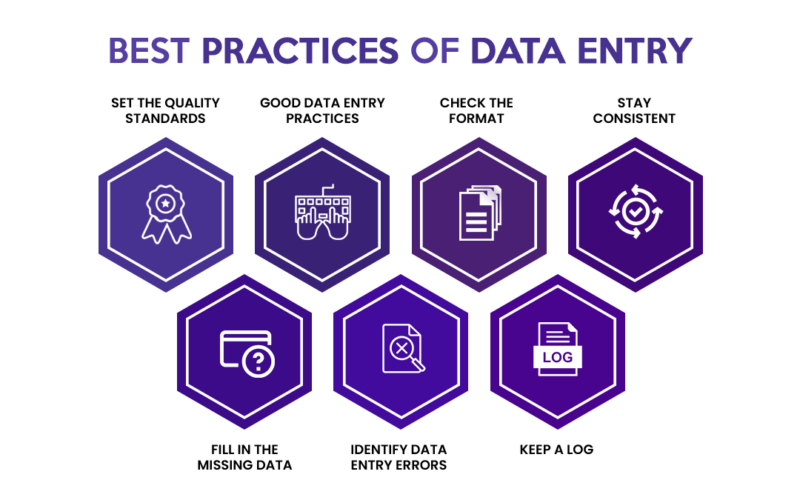
While necessary for maintaining correct and up-to-date data, data entry can be time-consuming, labor-intensive, and expensive for most startups and small to medium-sized businesses (SMBs). Companies are turning to external service providers specializing in data entry services to manage massive amounts of data while maintaining quality and precision.
There are several reasons why more companies are choosing to outsource data entry services. In this article, we will look into these benefits and discuss the steps for successful outsourcing, factors to consider, potential challenges to face when outsourcing data entry work, and how to overcome these challenges.
Benefits of Outsourcing Data Entry Work
Cost Savings
Outsourcing provides access to a global talent pool, frequently in regions with lower wage scales, resulting in significant cost savings. Infrastructure, technology, and training investments are reduced because the outsourcing partner takes care of these responsibilities. This approach reduces operational expenses and enables companies to allocate resources more efficiently, focusing on core capabilities and boosting growth.
Improved Customer Satisfaction
Outsourcing data entry work can improve data quality and organization. With a dedicated workforce managing data entry tasks, the accuracy and completeness of data improve. This means businesses can access more reliable and up-to-date information, enabling personalized and tailored customer interactions.
Access to a Larger Pool of Talent
Outsourcing companies often operate in different regions with distinct skill sets and competencies. This allows companies to choose from diverse professionals skilled in data input, management, and similar tasks. This access to specialized talent can increase accuracy and productivity in the data entry process.
Improved Efficiency
Through outsourcing, businesses can delegate time-consuming and repetitive data entry tasks to professionals in this field. This allows internal teams to focus on core business processes, strategic initiatives, and high-value tasks contributing to growth and innovation.
Steps for Outsourcing Data Entry Work Effectively
Define your data entry needs
Conduct a detailed analysis of the specific data entry work that your business needs. Determine the data types, formats, volume, complexity, and any guidelines that must be followed. Specify the accuracy levels and quality standards expected from the outsourced partner, including any validation that must be followed to ensure data integrity.
Additionally, your data security and confidentiality requirements should be made clear to the external service provider. Specify the guidelines on data processing, storing, and protecting sensitive information.
Research Outsourcing Options
After defining your data entry needs, research and create a list of outsourcing companies offering data entry services. Consider factors such as location, experience, and reputation. Explore online outsourcing marketplaces like Clutch and Outsourcing Gazette to find potential service providers. Review their profiles, ratings, and reviews.
We recommend checking out The New Workforce as you search for your data entry partner. The New Workforce is an outsourcing company that offers a range of services for affordable packages. They also provide outsourcing options for sales, marketing, IT, and customer service.
Develop a Clear Communication Plan
Determine the primary stakeholders in the outsourcing partnership. This includes the internal team and the outsourced workforce handling data entry tasks. Identify the communication channel to be used, like email, video conferencing, instant messaging, or phone calls.
Schedule regular meetings to discuss progress, updates, challenges, and upcoming tasks. Progress reports could include completed tasks, ongoing projects, issues encountered, and other KPIs relevant to the data entry work.
Implement and Monitor the Outsourcing Process
Conduct a kick-off meeting with the outsourced partner to formally launch the partnership. Review the project scope, expectations, communication plan, roles and responsibilities, and specific guidelines.
Share any relevant documentation, tools, and resources, and ensure they are familiar with your data entry processes. When sharing files with the external partner, ensure data protection and confidentiality measures are in place.
Implement a quality control process to assess the outsourced work. This could include random audits, spot checks, or systematic reviews to ensure accuracy and compliance with requirements. Provide the data entry specialists with timely and constructive feedback. Encourage them to share their insights for process improvement.
Factors to Consider When Outsourcing Data Entry Work
Quality of Services
When outsourcing data entry tasks, the quality of services is an important consideration to ensure accurate and reliable data management. In data entry, accuracy is critical. The data entry service provider should have a track record of maintaining a low error rate in their work. Inquire about their quality control processes, strategies for detecting and rectifying errors, and data integrity.
Assess the provider’s level of expertise in data entry and similar industries. Accuracy and efficiency are often correlated with the level of experience. Look for specialized experience in your industry, as it can contribute to a better comprehension of the data being entered.
Data entry may be subject to certain legal and compliance requirements depending on your industry. Ensure that the outsourcing partner is aware of and compliant with these regulations.
Availability and Accessibility
Inquire about the outsourced partner’s typical response times for queries and concerns. A partner who responds promptly will more likely address issues quickly and keep the project on time. If your data entry jobs include peak periods or deadlines, ensure your outsourced partner can meet these demands and maintain availability.
Availability and accessibility expectations should be included in the SLA or contract. Define parameters like response times, communication frequency, and availability during critical periods.
Cost
Understand the outsourcing company’s pricing model and choose one that fits your budget and project requirements. Beyond the initial cost, consider the overall cost of ownership, including hidden or additional fees. This could include initial setup costs, software licenses, and ongoing maintenance.
Consider outsourcing to regions where the cost of living is lower, as this can result in cost savings without compromising the quality. Check if the data entry company requires a long-term commitment. Flexibility in the contract duration allows you to adjust the arrangement depending on the demand.
Cultural Compatibility
Check the outsourcing partner’s business etiquette and practices to ensure they align with your expectations. This could include punctuality, meeting etiquette, and professional norms. For a partnership to be effective, there must be a shared commitment to excellence, integrity, and professionalism.
Tips for a Successful Outsourced Data Entry Work
Foster Open and Clear Communication
Define project expectations, scope, and deliverables clearly from the start, and conduct regular meetings to handle inquiries and updates. Use various communication channels to ensure efficient information exchange. There should be a single point of contact on both sides to streamline communication and establish a feedback loop for continual improvement. To avoid misunderstandings, encourage questions, provide detailed instructions, and respond to queries.
Maintain a consistent brand voice
Every piece of data, whether inputting customer information or updating product details, should reflect your brand’s tone and identity. To ensure proper representation, clearly communicate your brand’s guidelines, values, and style to the data entry operators. Provide templates, examples, and instructions that mirror your brand’s voice in all data entries. Review and provide comments regularly for alignment and to make any necessary adjustments.
Use Technology to Your Advantage
Use advanced data entry software, automation tools, and artificial intelligence to streamline and expedite the process. Implement data validation methods to reduce errors and use optical character recognition (OCR) technology to convert printed text to digital format efficiently. Furthermore, use data security measures such as encryption and access controls to protect sensitive information.
Continuously evaluate and improve the outsourcing process

Constant evaluation and improvement of the outsourcing process is a key strategy for ensuring the success of outsourced data entry work. Assess the effectiveness of workflows, communication protocols, and performance metrics to identify areas for improvement. Analyze the data entry quality, turnaround times, and adherence to the project timeline. Gather feedback from your internal team and your outsourcing partner to gain insights into opportunities for improvement.
Potential Challenges of Outsourcing Data Entry Work and How to Overcome Them
Language Barriers
One potential challenge associated with the language barrier is the accurate interpretation of data. Data entry tasks typically require understanding and transcribing information from different sources. Language barriers can cause misinterpretation, leading to errors, inconsistencies, and data inaccuracies. To overcome this,
- Provide clear and standardized guidelines for data entry. Provide templates, samples, or guidelines for entering data, including date formats and numeric representations.
- Use data validation rules within the data entry system. This can help avoid the entry of erroneous or inconsistent data.
- Provide a glossary of industry-specific terminologies and acronyms that may be encountered during data entry. This can help ensure consistent and accurate interpretation
Time Differences
Managing the time differences between your business and the outsourced team is a significant challenge when outsourcing to regions with different time zones. This can negatively impact communication, project coordination, and overall efficiency. To address this,
- Set up overlapping working hours between your internal team and the outsourced workforce. This enables real-time communication and collaboration during each team’s workday.
- Define clear communication protocols, such as preferred communication channels, response times, and update expectations, to ensure that messages are received and addressed on time.
- Maintain shared calendars that show team members’ availability across different time zones. This can help avoid scheduling problems and make coordination easier.
Maintaining Control Over the Customer Experience
Outsourcing data entry work can introduce challenges in maintaining control over the customer experience, especially when the data being handled is crucial to customer satisfaction. Ensuring consistent quality, accuracy, and adherence to customer expectations becomes critical. To overcome it,
- Conduct training sessions to familiarize the outsourced team with your brand values and customer service requirements. Emphasize the importance of accuracy, attention to detail, and maintaining a positive customer experience.
- Implement a method for monitoring the performance of the outsourced team. Review samples of completed data entry tasks to ensure they meet your quality needs.
- Establish clear escalation procedures for dealing with any customer-related issues or complaints that arise from outsourced data entry. Ensure the external team understands how to properly escalate and resolve customer issues.
Outsourcing data entry services can be efficient for companies looking to streamline their operations and focus on core activities. Companies can get better accuracy, save on costs, and improve efficiency by leveraging the expertise of outsourcing partners. To develop a successful outsourcing relationship, thorough planning, careful vendor selection, and open communication are required. Factors such as quality of services, availability, cost, and cultural compatibility must be considered when searching for potential outsourcing partners. Implementing these strategies can help businesses achieve operational excellence and foster long-term success.



Leave A Comment
You must be logged in to post a comment.